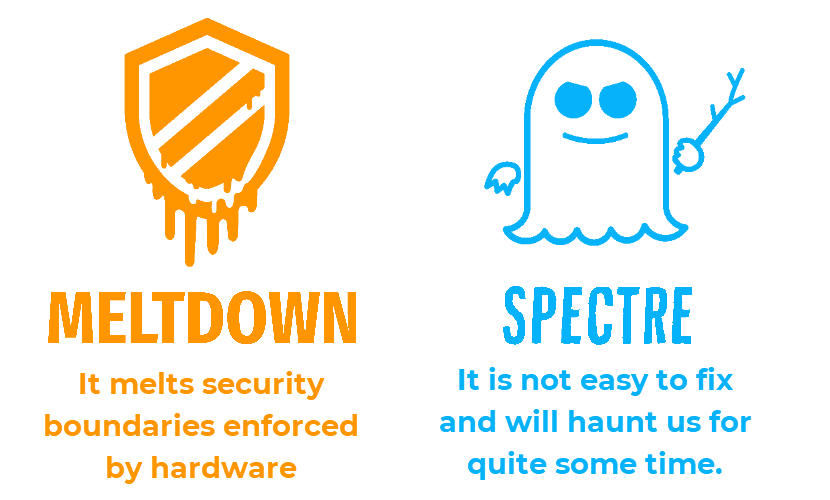Few events in the history of cybersecurity have been as impactful as the discovery of Meltdown and Spectre. These vulnerabilities are embedded within the very architecture of modern CPUs, including AMD, Intel, and ARM processors.
While mitigations for Meltdown and Spectre exist, they are still a threat, and eliminating them is difficult. Furthermore, researchers are still discovering new variants of these vulnerabilities.
This article will explain what Meltdown and Specter are, how they work, and how to defend against them.
What are Spectre and Meltdown?
Spectre and Meltdown are often used interchangeably, but they are distinct variants of the same underlying vulnerability.
Spectre is a broader term encompassing a family of methods for exploiting CPU design to gain unauthorized access to data. On the other hand, Meltdown is a specific instance of utilizing Spectre techniques to access the kernel's memory, which grants access to any memory within the computer.
The Discovery and Impact of Meltdown and Spectre
In 2017, researchers from Google Project Zero, Cyberus Technology, and Graz University independently discovered Meltdown and Spectre. They kept the vulnerabilities confidential until 2018 to give affected vendors time to develop mitigations. The researchers publicly disclosed the vulnerabilities on January 3, 2018, sending shockwaves through the tech industry.
At the time, Meltdown and Spectre impacted nearly every contemporary computing device, including smartphones, tablets, cloud servers, and PCs across various brands and operating systems. These vulnerabilities could, in theory, grant attackers unprecedented access to sensitive data like passwords and encryption keys.
Often considered one of the most severe CPU flaws ever identified, the discovery of Meltdown and Spectre led to a flurry of activity as companies scrambled to patch their systems and protect their data. The fallout was swift and severe, causing financial and reputational damage to the affected companies.

How Do Spectre and Meltdown Work?
Spectre and Meltdown are distinct yet interrelated variations of the same technique that exploits CPU performance features introduced over 20 years ago: the “out-of-order” and “speculative” executions. These performance optimizations created a vulnerability that allowed attackers to manipulate the processor's speculative state and access data that would otherwise be inaccessible, breaching the protective barriers enforced by operating systems and programs.
The out-of-order execution allows the CPU to reorder instructions to improve efficiency, potentially accessing data before security checks are applied. Meltdown leverages the out-of-order execution to access memory that should be inaccessible to certain processes, breaking the isolation between the operating system and user applications.
In contrast, speculative execution enhances processing speed by pre-executing instructions that the CPU predicts will be necessary shortly. If the prediction is correct, the processor saves time by not waiting for the instructions. If the prediction is wrong, the processor will simply discard the work. Spectre exploits this feature of CPUs to speed up processing. It is particularly effective in scenarios with conditional branches, as the CPU does not wait for the resolution of the branch and exposes data in the process.
Spectre and Meltdown: A Quick Overview
Here is a table that outlines the key features of these two vulnerabilities:
| Meltdown | Spectre | |
| Affected processors | Intel, Apple | Intel, Apple, ARM, AMD |
| Attack mechanism | Breaks the mechanism that keeps applications from accessing arbitrary system memory | Tricks other applications into accessing arbitrary locations in their memory |
| How hard is it to exploit? | Easier to exploit | Much harder to exploit |
| How hard is it to mitigate? | More straightforward to patch | Hard to mitigate |
| Allows kernel memory read | Yes | No |
| Can be executed remotely | Sometimes | Yes |
| Most likely to impact | Kernel integrity | Browser memory |
| Overall risk | Large risk due to its ease of exploitation and severity of the data that can be leaked | Significant threat, but less immediate than Meltdown due to its difficulty of exploitation |
Examples of Spectre and Meltdown Attacks
Despite their destructive potential and wide range of attack vectors, the threat of data theft through Spectre and Meltdown remains hypothetical. There have been no confirmed cases of exploitation in the real world. Still, we cannot know for sure, as data breaches that exploit Spectre and Meltdown leave no identifiable traces in traditional logs and were, until recently, practically undetectable by antivirus software.
However, researchers have demonstrated various proof-of-concept attacks. These scenarios often require ideal and unrealistic conditions, such as unrestricted access to the target system. In real-world situations, attackers face practical limitations, such as low data exfiltration rates, contamination of exfiltrated data with irrelevant information, and the need to exploit vulnerabilities in specific target configurations. Additionally, continuous patching and the development of mitigation techniques hinder the practical feasibility of Spectre and Meltdown exploitation.
Let us explore some examples of attacks that leverage the Spectre and Meltdown vulnerabilities.
NetSpectre
NetSpectre is a theoretical type of Spectre attack that can be launched over a network. Attackers do not need local code execution on the target system to exploit the vulnerability. Instead, they can send a series of crafted requests to the target machine and measure the response time to leak a secret value from its memory.
NetSpectre attacks require many measurements to distinguish bits with a reliable confidence. However, the researchers who created this theoretical attack have verified that they work in local-area networks and between virtual machines in the Google cloud.
Another important note is that NetSpectre's data exfiltration rate is relatively low, ranging from 15 to 60 bits per hour. This slow pace makes it challenging to steal large amounts of data fast.
Leaky.Page
Leaky.Page is Google's demonstration of a Spectre exploit within a web browser, exemplified using Google Chrome. While the code specifically targets Chrome, the vulnerabilities extend to other browsers. The interactive exhibit effectively illustrates data leakage, achieving a speed of 1kB/s on Chrome 88 running on an Intel Skylake CPU.
The accompanying code, accessible on Github, encompasses the Spectre gadgets and side-channel mechanisms responsible for triggering controlled transient execution and observing its effects.
The release of this proof of concept was a strategic effort to raise awareness among web application developers about Spectre risks, prompting them to consider these threats in security evaluations and take proactive measures to fortify their sites.
Spook.js
Spook.js is a JavaScript-based attack that targets a Chromium-based browser’s site isolation security mechanism. It exploits weaknesses in the browser's speculative execution behavior to leak sensitive information from other websites and extensions open in the same browser window.
Despite Chrome's measures to isolate websites and prevent potential attacks, multiple pages from the same site or domain grouped in a common browser process created a vulnerability that the Spook.js attacks managed to exploit.
Like with Leaky.Page, researchers created Spook.js to demonstrate the power of Spectre exploits and recommend new measures for website security, such as moving authorization pages to a separate domain. Google Chrome developers have since enhanced mechanisms for site isolation, and while future studies may refine attack methods, existing security measures will likely continue to address similar vulnerabilities.

Spectre and Meltdown Patches
In the wake of the discovery of Spectre and Meltdown in 2018, a frenzied effort ensued to patch and secure affected systems, accompanied by concerns about the potential performance impact of these fixes. However, as of 2023, the primary Spectre and Meltdown variants have been effectively mitigated with a relatively modest impact on CPU performance, especially in newer processors with more cores.
If you have updated your operating system to the latest version, you are almost certainly patched for Meltdown and Spectre. To ensure you are protected, you can use a tool like a Spectre & Meltdown CPU Checker.
While CPU manufacturers have addressed the known Spectre and Meltdown variants, these vulnerabilities are intrinsic to the way processors are conceived. As long as CPUs rely on speculative execution, new, potentially more devastating variants can arise.
How to Protect Against Spectre and Meltdown
When a processor vulnerability is discovered, there are three main approaches to addressing it:
- Microcode updates. Vendors can release microcode updates, which are essentially patches for the processor's firmware. These updates are applied to existing processors to fix known vulnerabilities. For example, Intel created Spectre- and Meltdown-specific microcode patches for processors as old as the fourth-generation Haswell architecture cores from 2013.
- Hardware modifications. In some cases, making changes to the physical design of the processor may be necessary to address a vulnerability fully. However, these changes can only be implemented into future processor generations. Intel's 9th-generation processors from 2019 onwards are the first generation of new desktop CPUs to incorporate hardware fixes for the Spectre and Meltdown vulnerabilities.
- Software-based mitigation. Software-based mitigation techniques involve modifying operating system software or other software components to make it more difficult for attackers to exploit a vulnerability. Due to Spectre and Meltdown's quick rise to fame, software-based mitigation techniques were developed and implemented in most operating systems and other applications as early as 2018.

Essential Cybersecurity Practices
While we cannot control the actions of CPU manufacturers or hackers, we can mitigate risks by practicing good operational security.
Here are some practical recommendations for avoiding a wide range of online threats:
- Regularly update your operating system and web browser to ensure you have the latest security patches and features.
- Employ a reputable, up-to-date antivirus and anti-malware solution to scan your system and remove harmful software.
- Be mindful of the websites you visit and the files you download. Avoid suspicious or untrusted websites, and only download files from reputable sources.
- Avoid clicking on links or opening attachments in emails from unknown senders. These emails might be phishing attempts.
- Create strong passwords for all your online accounts and use a password manager to store and manage them securely.
- Whenever possible, enable two-factor authentication for your online accounts.
- Avoid using unsecured public WiFi networks for sensitive activities like online banking or shopping.
- Create regular backups of your important data to protect against loss or corruption.
Latest Update Regarding Spectre and Meltdown
In 2022, researchers successfully developed a cutting-edge intrusion detection system capable of identifying transient attacks in the microarchitecture layer (hardware) before data leakage. They created the first machine learning accelerator (MLA) specifically designed for security applications and intended for integration into Intel chips.
An MLA is a specialized computer system designed to speed up the performance of machine learning applications. MLAs are typically used to train and run large, complex models, such as deep neural networks, and provide a significant performance boost over general-purpose CPUs and GPUs.
The security MLA operates at unprecedented speed, sampling the activity of transient instructions every one nanosecond and making predictions every ten nanoseconds. This exceptional speed enables the detection of transient attacks such as Spectre and Meltdown before any data leakage occurs. Additionally, the technology automatically activates countermeasures within the chip to further enhance protection.
To ensure robustness against evolving attack strategies, the researchers equipped the technology with adversarial training. This method exposes the technology to diverse variants of the Spectre attack, making it immune to even the most sophisticated attempts to circumvent its detection capabilities.

Looking Ahead
While Spectre and Meltdown have been highly influential, their exploitation has been limited. No known malware has leveraged these vulnerabilities, and the immediate risk of real-world attacks remains low. Moreover, proof-of-concept demonstrations have either led to effective patches or revealed that hackers would require highly improbable circumstances for execution. Ultimately, the very nature of Spectre and Meltdown proved to be their undoing. Their severity triggered an avalanche of patches and mitigations, which hindered anyone from exploiting them effectively.
We must not become complacent, though. There is a genuine possibility that hackers may invent methods of bypassing existing defenses, or that more dangerous variants may emerge.
In the long run, a radical hardware redesign may be necessary to thoroughly address the underlying flaws that enabled Spectre and Meltdown. This undertaking would undoubtedly be challenging, but it is the only path to permanently eradicating Spectre.



